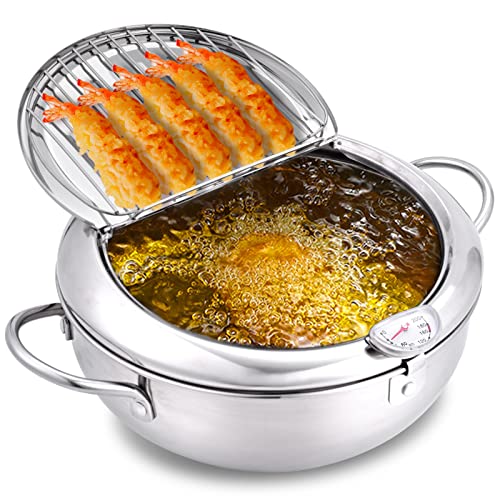Ever wondered how to achieve that perfect golden crispiness when deep frying on your stovetop? It’s all about getting the temperature just right. Too hot and you’ll burn the outside while leaving the inside raw; too cool and your food will soak up oil like a sponge, turning greasy instead of crunchy.
Mastering stovetop deep frying might seem daunting, but with a few simple tips, you’ll be frying like a pro in no time. Whether you’re making crispy fries, golden fried chicken, or delicious donuts, understanding the nuances of oil temperature can make all the difference. So, let’s dive into the sizzling world of deep frying and discover how to get that mouthwatering crunch every time.
Understanding Deep Frying on a Stovetop
Deep frying on a stovetop may seem daunting, but it’s straightforward. Knowing and maintaining the right temperature is key.

The Basics of Deep Frying
Select an oil with a high smoke point, like canola or vegetable oil. Fill your pot with enough oil to submerge the food completely. Use a thermometer to monitor the oil temperature. Aim for 350°F to 375°F (177°C to 190°C) for most foods. Below this range, food absorbs oil and gets greasy. Above this range, the food burns quickly, turning dark and bitter.
Importance of Maintaining the Right Temperature
Maintaining consistent temperature ensures even cooking. If oil cools down, food turns soggy or greasy. If oil overheats, food burns on the outside and stays raw inside. Adjust the heat as needed using a thermometer. Remove and drain excess oil using paper towels or a cooling rack to keep food crispy. Proper temperature control gives you golden, crispy results every time.
Choosing the Right Oil for Deep Frying
Selecting the right oil impacts the flavor and texture of your deep-fried foods.
Factors Affecting Oil Selection
- Smoke Point: Choose oils with a smoke point above 375°F (190°C) to prevent burning.
- Flavor: Opt for neutral-flavored oils to maintain the food’s taste.
- Cost: Consider affordability if deep frying frequently.
- Peanut Oil: Smoke point around 450°F, neutral taste.
- Canola Oil: Smoke point near 400°F, budget-friendly.
- Sunflower Oil: Smoke point approximately 440°F, mild flavor.
- Vegetable Oil: Versatile, smoke point up to 450°F.
Choosing the right oil ensures optimal deep-frying results on your stovetop.
Setting Up Your Stovetop for Deep Frying
You’ll need the right setup to safely deep fry on your stovetop. Proper prep ensures consistent results.
Equipment Needed for Stovetop Deep Frying
- Heavy-Duty Pot: Use a deep, heavy-duty pot. Cast iron or stainless steel works best.
- Oil Thermometer: An oil thermometer is essential. Monitor temperatures accurately.
- Spider Strainer: Use a spider strainer or slotted spoon. Safely remove food from the hot oil.
- Oil: Choose an oil with a high smoke point. Peanut oil, canola oil, and sunflower oil excel.
- Baking Sheet: Use a baking sheet lined with paper towels. Drain excess oil efficiently.
- Tongs or Chopsticks: Manage food with precision. Tongs or chopsticks are ideal.
- Monitor Oil Temperature: Never leave oil unattended. Overheating can lead to fires.
- Avoid Water: Water and hot oil don’t mix. Ensure foods are dry before frying.
- Use a Lid: Keep a lid nearby. Smother flames if a fire starts.
- Ventilation: Ensure proper ventilation. Reduce smoke and odors in your home.
- Child and Pet Safety: Keep children and pets away. Hot oil can cause severe burns.
- Extinguisher Ready: Have a fire extinguisher nearby. Use it in case of emergencies.
Monitoring and Controlling Temperature
Monitoring and controlling oil temperature guarantees the best results when deep frying. Staying within the optimal range of 350°F to 375°F is essential for achieving crispy, evenly cooked foods.
Tools for Temperature Measurement
Use a reliable tool to track oil temperature. A candy or deep-fry thermometer attached to the side of the pot provides the most accuracy. Digital instant-read thermometers also give quick readings. Ensure your thermometer can handle high temperatures, ideally up to 400°F.
What to Do When Temperature Varies
When oil dips below 350°F, food absorbs more oil, becoming greasy. Increase the burner heat slightly to bring the temperature back up. If the oil exceeds 375°F, reduce the heat or remove the pot momentarily to prevent burning. Dispose of oil if it reaches its smoke point, and start fresh to avoid off-flavors.
Conclusion
Mastering the art of deep frying on your stovetop can elevate your cooking game to new heights. By maintaining the right temperature and using the proper tools, you’ll achieve that perfect golden crispiness every time. Remember to choose the right oil, monitor the temperature closely, and adjust the heat as needed.
With these tips and a bit of practice, you’ll be whipping up delicious, crispy treats like a pro. Enjoy the process and savor the results! Happy frying!









